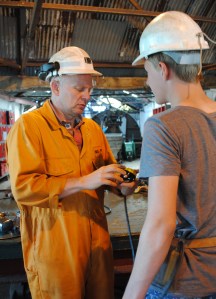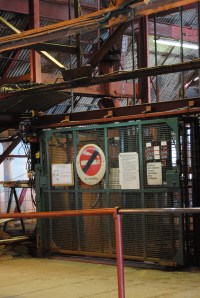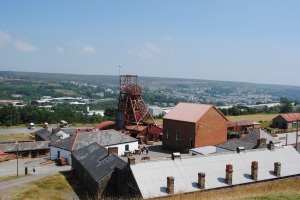One of the great things about having family and friends come to visit me in Wales is that I get to go to all the places that I usually wouldn’t find time for. So, when my dad told me that he’d never been down a mine, I saw it as a great opportunity to spend a perfectly nice (and very rare) hot, sunny day underground.
 Big Pit, in the beautiful surroundings of Blaenavon in South Wales, was once a working coal mine and is now a fantastic museum that not only teaches you about the history of the area but also gives you a glimpse of what it was like for miners working underground throughout the ages. Like all the national museums in Wales, Big Pit is completely free of charge, although it costs £3 to use the car park and there are opportunities to make a donation should you choose to.
Big Pit, in the beautiful surroundings of Blaenavon in South Wales, was once a working coal mine and is now a fantastic museum that not only teaches you about the history of the area but also gives you a glimpse of what it was like for miners working underground throughout the ages. Like all the national museums in Wales, Big Pit is completely free of charge, although it costs £3 to use the car park and there are opportunities to make a donation should you choose to.
We began our day with a descent into the old colliery, 90m underground. This was a new experience for me. Although I have visited mines before, they were all drift mines in the north of England that you walk into. Never before had I travelled down in a lift. There was no conning myself into believing that we weren’t that deep this time, that rickety old lift reminds you just how far under the surface you really are. Before entering the lift you have to be kitted out with a genuine miner’s helmet (complete with lamp) and a safety belt should anything go wrong whilst you’re underground.
Unfortunately, safety rules at the mine mean that you’re not allowed to take a camera down with you. In fact,  you’re not allowed to take anything that has a battery so watches, phones and other electricals have to be left on the surface. Although the mine has been cleared of all dangerous gases nowadays, they don’t want to take any chances.
you’re not allowed to take anything that has a battery so watches, phones and other electricals have to be left on the surface. Although the mine has been cleared of all dangerous gases nowadays, they don’t want to take any chances.
If you are at all scared of entering the pit, I assure you that the worst part is the lift journey down. You’re crammed in like sardines, and you start to envy the canaries because at least they have a bit of personal space in their little cages. It’s all part of the experience, though, and this is how the miners commuted to work every day.
All the guides at the pit are ex-miners, and our guide Andrew was incredibly entertaining and informative as he led us around the labyrinth of underground tunnels. Originally from North Wales, Andrew is from a mining family who moved to the south for work. Hearing what it is like to work beneath the earth’s surface from a real miner is fascinating, and Andrew was also able to help us experience what it would have been like for his ancestors. He told us about the young boys, sons of miners, whose job it was to open and close the fire doors as the carts full of coal rolled through. Unpaid, working purely for the hope that one day they would too be given a paying job in the mine, the boys would sit in the darkness waiting for the rumble of the carts to come along. Only the lucky ones, whose families were wealthy enough to afford one, would be given a candle. Andrew told us all to turn off our headlamps, and we were in complete darkness. I can only imagine what those young boys went through, sat in such a lonely atmosphere for hours on end.
 It’s not only humans that worked under the ground. The canaries, once used to test for dangerous gases in the mines, now have a happier existence above ground in another part of the museum. We also got to see the underground stables where the pit ponies lived whilst they were at work. Walking along the stalls and reading the names of the ponies still chalked onto a small blackboard next to each one is a stark reminder of the sacrifices that other species have made for us at our command.
It’s not only humans that worked under the ground. The canaries, once used to test for dangerous gases in the mines, now have a happier existence above ground in another part of the museum. We also got to see the underground stables where the pit ponies lived whilst they were at work. Walking along the stalls and reading the names of the ponies still chalked onto a small blackboard next to each one is a stark reminder of the sacrifices that other species have made for us at our command.
Above ground, original buildings from the pit head continue the experience. The locker room features individual stories of people who worked at the mine, not just the miners but also support staff such as those who ran the canteen. The canteen is also still there by the way, and not only sells traditional Welsh treats but also offers the most amazing view of the valley and is well worth the climb up the steps to reach it. You can even walk through the shower block where the men would wash away all the dirt and coal dust.
Halfway back down the hill, between the bath house/canteen and the pit shaft, is  the mining galleries. Probably the most modern part of your visit, this multimedia experience is a must to learn about mining techniques through the ages.
the mining galleries. Probably the most modern part of your visit, this multimedia experience is a must to learn about mining techniques through the ages.
I am so glad that I made the time to visit Big Pit. If you do manage to find your way there some day, you should also visit the other Blaenavon World Heritage attractions such as the ironworks, steam railway and the canal, not to mention the town of Blaenavon itself.  Faced with the loss of their main income, the locals here have refused to just sit on their backsides and complain. Like a lot of communities in similar situations here in Wales, they have created a new industry and in the process jobs for their town. They have transformed Blaenavon into a tourist attraction that is a must for visitors to South Wales, and I cannot wait to return.
Faced with the loss of their main income, the locals here have refused to just sit on their backsides and complain. Like a lot of communities in similar situations here in Wales, they have created a new industry and in the process jobs for their town. They have transformed Blaenavon into a tourist attraction that is a must for visitors to South Wales, and I cannot wait to return.

